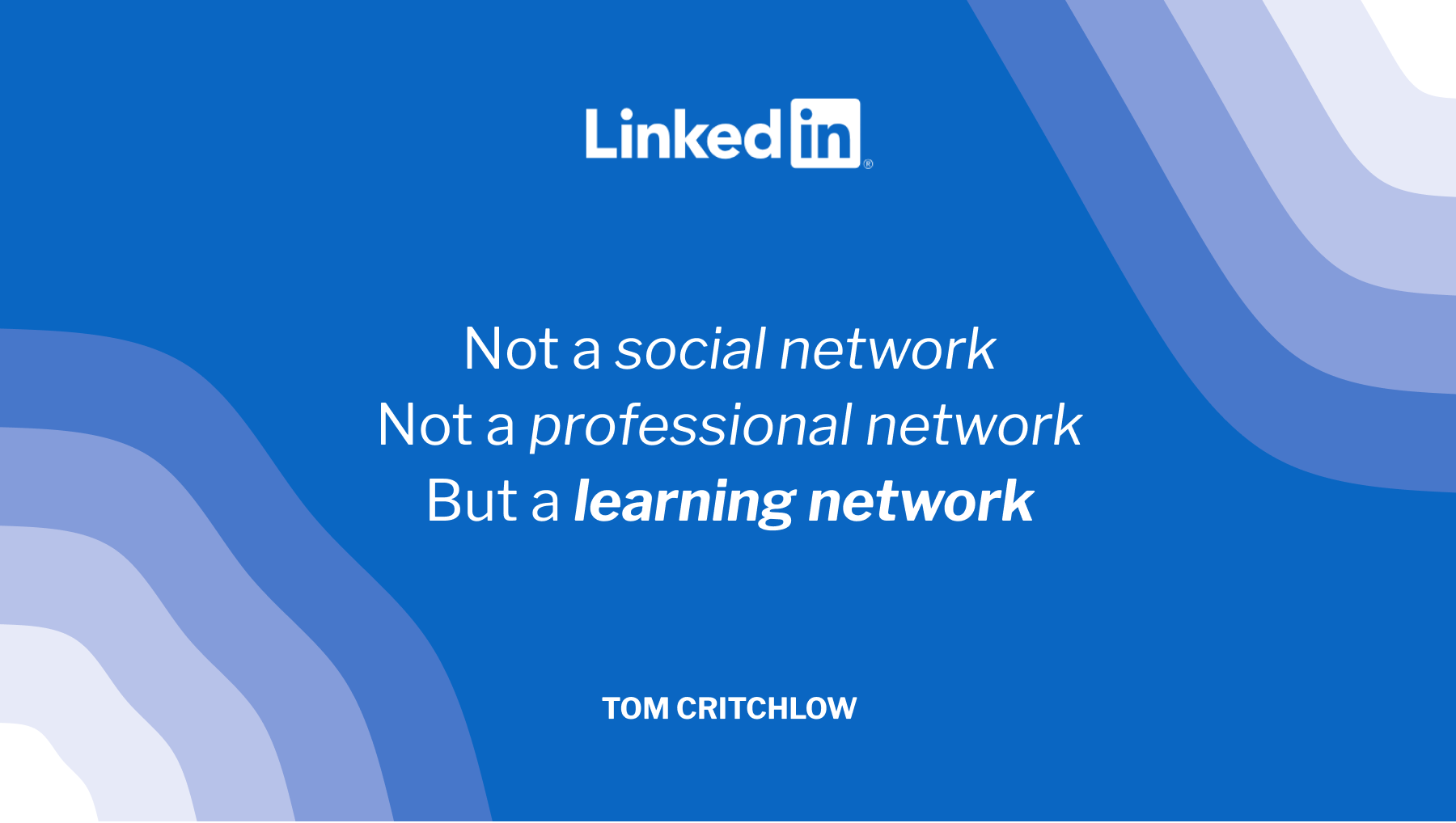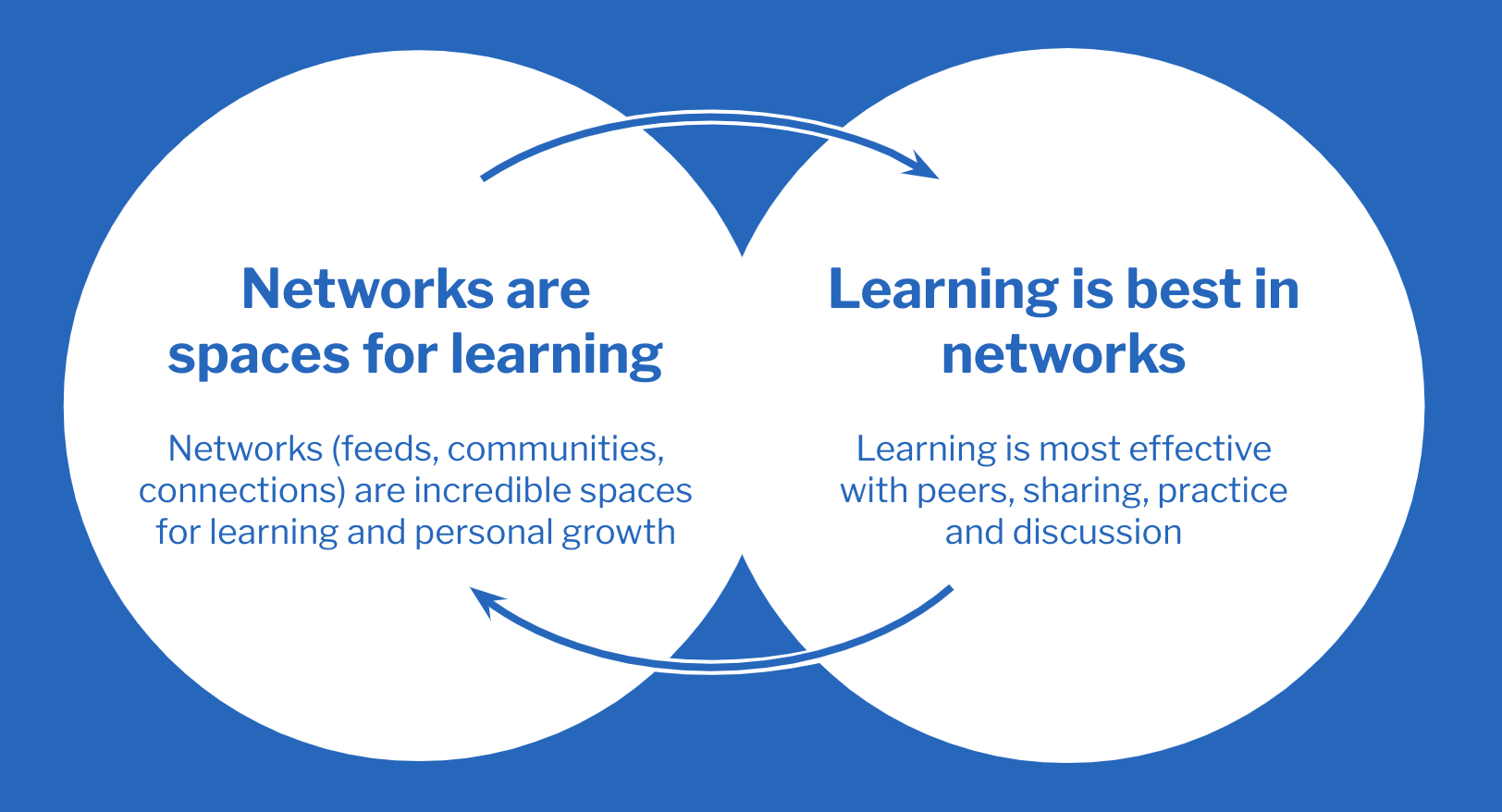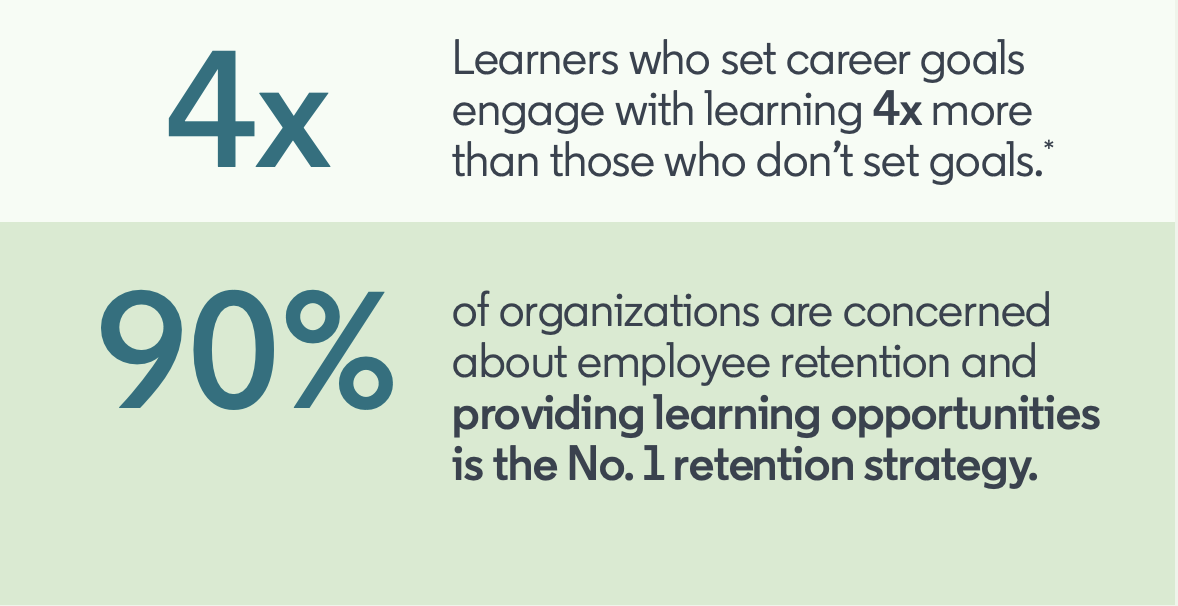LinkedIn is not a social or professional network, it's a learning network
The world of work needs a new script
The world of work is changing.
AI, WFH & layoffs. WTF. The social contract between employers and employees is weakened. In this world of work - people don’t want to engage with a professional network.
Meanwhile, in a world of doomscrolling, algorithmic feeds and fake news - social media is the new tobacco. People don’t want to engage with another social network.
So we need a new script for the world of work. Maybe the future is… LinkedIn?
I think LinkedIn has a unique opportunity - a cultural moment around work, coupled with a unique proposition: real networks and real utility.
What if LinkedIn positioned itself not as a professional network or social network but as a learning network. A personal learning network for every user - centered on their personal development.

First, let’s dive into how the world is changing.
Part 1: Changes in the World of Work
1.1 The Employer / Employee Relationship is Weakening
People don’t want to lean in, they want to sit down. Everyone everywhere is tired all the time. My friend Gautam has an incredibly insightful series connecting work memes to employee engagement stats to take a close look at “what’s going on” and the vibe shift in the world of work:
The final reason for our collective discontent is the dissonance between what we see in the economy and our lives. I am not here to debate if there is an actual connection in any of these examples - it’s about the perception that drives emotions of disengagement. In Vietnam, a booming economy didn’t translate into paychecks. The country’s economic gains haven’t been felt among the young - and housing has gotten worse. How is it that the S&P in the West and Nikkei in the East have been smashing records but we’re yet to contain the layoff contagion? When Google laid off people last year, the biggest head-scratcher for my peers was ‘how could a company sitting on $100B in cash need layoffs?’
It didn’t matter what the (however logical) explanation was, it made them change how they felt about their work.
If the stability of jobs is at risk - why care about that promotion or getting ahead? Maybe one frame is through taking control of your own personal development and learning: after all “learning is the one thing your employer can’t take away from you”
Summary: In a world of quiet quitting, positioning LinkedIn as a professional network just doesn’t feel right.
1.2 Social Media is the new Tobacco
Meanwhile, social media is the new tobacco. Last year the surgeon general issued a stark warning for social media companies about the risks of social media and mental health.
Social media can present a real risk to the mental health of children and teenagers because of the ways their brains are affected by the amount of time they spend using it, the U.S. surgeon general warns in a new advisory released Tuesday.
"Teens who use social media for more than three hours a day face double the risk of depression and anxiety symptoms, which is particularly concerning given that the average amount of time that kids use social media is 3 1/2 hours a day," the Surgeon General Dr. Vivek Murthy told Morning Edition host Steve Inskeep.
Spoiler alert: it’s not just about teens. We’re all spending too much time on social media and while the effects are blended - we suffer the same downsides of depression and anxiety. Comparing ourselves to others, feeding dissociation and angering us.
Every social network has chum content and LinkedIn is no different. Over the years we’ve seen the rise of bro-etry and cringe “thought leadership” and crying CEOs. When I scroll my feed I have to sidestep the clearly threadboi and #personalbrand engagement-farming posts and try and focus on the real content.
The laws of enshittification1 for social networks says that the most profitable thing would probably be for LinkedIn to just turn up the dials on engagement farming - but how is that working for X and Facebook? What we need is a vision for a social network that has actual utility, not doomscrolling.
Summary: In a world of addictive social media, positioning LinkedIn as a social network just doesn’t feel right.
1.3 Online Education is still just getting started
Online education absolutely exploded in the immediate aftermath of the pandemic. The subsequent pullback is not a bearish sign but merely a renormalization of growth. I believe we’re still just getting started with online education.
Some of the dryest stats are the most mind-blowing:
— Kasey Klimes (@kaseyklimes) March 21, 2024
E-learning is a $214B market (project management software is a measly $6B, for comparison) with an expected compounded annual growth rate of over 20% between now and 2030.
Sure E-learning is a $200B+ market but that doesn’t even account for the variety of different types of online learning that happen. Look at Masterclass, Reforge, Maven and more. We are living in an explosion of online education. But it’s not just courses, it’s real work examples, mentorship and more.
And of course, AI is going to completely reshape the skills landscape in the next decade.
Summary: In a world where we’re experiencing the biggest transformation of workplace skills ever - we’re just getting started with online education.
Part 2: Communities of Practice
2.1 Learning Happens in Networks
Learning is a doing word2. We know that learning happens best in networks and communities:
Learning, in other words, occurs in communities, where the practice of learning is the participation in the community. A learning activity is, in essence, a conversation undertaken between the learning and other members of the community.
This is the positive reframe of “networking”. Networking is useful, but distasteful to many. Instead, participating in self-directed learning communities is networking:
In modern working life, professionals need to perform flexibly and independently in ever–changing environments. To be able to do this effectively, they depend on various lifelong learning skills, among others autonomous and self–directed learning.As they are partly supported in their learning by interaction with their peers, an essential life–long learning skill they need to develop, is the ability to find and to connect with relevant others, i.e., professional networking.
This is the north star for LinkedIn - to be a place where networks and learning come together into communities of practice. Enabling everyone to use LinkedIn to create their own personal learning network:

2.2 L&D is Broken
Companies invest billions in “L&D” but learning is rarely the outcome:
The leadership development industry, however, is in a state of upheaval. The number of players offering courses to impart the hard and soft skills required of corporate managers has soared. And yet organizations that collectively spend billions of dollars annually to train current and future executives are growing frustrated with the results. Several large-scale industry studies, along with our own in-depth interviews with clients, indicate that more than 50% of senior leaders believe that their talent development efforts don’t adequately build critical skills and organizational capabilities.
In fact L&D has a lower NPS than Verizon!
Corporate Training is a $336 billion industry globally ($166 bn in the US). Within that, $3.4 bn was spent on leadership training, one of the fastest-growing learning and development segments. Millennials rate training & development as their #1 desired job benefit, beating out flexible work schedules and cash bonuses, and High Impact Learning Organizations grow profits 3x faster than non-HILOs.
Despite that, L&D programs have an abysmal -8 Net Promoter Score. For context, Verizon has an NPS of 7 and Tesla’s is 96. People hate the training they’re getting more than they hate waiting for the cable guy to inevitably miss the 8-hour appointment window.
You can sum up the typical approach to L&D as: the answer is training! (what was the question?). We need new ideas.
2.3 Learning is More Than Skills
The world of work needs radically new models for how we learn and what we learn. Not just because of AI, but that ain’t gonna help for sure. We need new models of soft skills, interpersonal skills, creative skills and faster deployment of technical skills to keep up.
The report argues that the convergence of these trends will likely result in a world of work requiring specific knowledge and skills, especially complex thinking and interpersonal capabilities. As the future of work unfolds, what makes us human is what will make us employable.But the pathway to sustained employment will not be linear. No single job will be a final destination. Maintaining a career will require a lifetime of learning. An education system fit for this evolving world - one which will value and strengthen essential human traits will require significant reform
This is a path that LinkedIn is championing, here’s a quote from LinkedIn CEO Ryan Roslansky
A year ago we shared our aspiration to help accelerate the shift to a skills-first approach to hiring. Since then, we helped more than 400,000 companies make a skills-first hire in 2021. Now, 40% of hirers on LinkedIn are using skills data to find talent, up 20% year-over-year. What’s more, these hirers are 60% more likely to find a successful hire than those not relying on skills as part of their hiring process. Simply put, a skills-first labor market is emerging all around us.
And a quote from Tomer Cohen, head of product at LinkedIn:
For example, skills are becoming one of those tremendous behavior changes we’re seeing on the platform as well.
What do you mean by skills as a tremendous behavior change?
I think for many years we really believed in the notion that there was a primary focus for every professional, and believed in skill matching between an employer and employees. If I want to hire somebody on your team for a job, I would look first and foremost at their skills. For years, the industry has relied primarily on pedigree and which companies you work for. Now we’re seeing more and more that there is, in my opinion, a tremendous change towards focusing on the skills you have.
For example, we have tools that we offer to recruiters, which are able to create a pipeline of candidates, to source, and to reach out. We’re seeing close to almost 50 percent of recruiters using skills right now to look for professionals. That’s a big deal. That wasn’t the case before, and it’s increasing a lot.
We need a complete re-thinking of education, courses and learning. It’s as much mentorship and communities as it is courses and certificates.
2.4 Learning is What Employees AND Employers Want
Learning is the thing that both sides want:
In today’s high-pressure labor market, a lack of advancement opportunities was the number one reason employees left their jobs last year.
Employees want to grow, learn and develop. Companies want engaged, capable workers. It’s a win win. LinkedIn agrees obviously:
Part 3: A New Brand for LinkedIn
3.1 The Brand Concept: LinkedIn as a Learning Network
If anyone has the opportunity to come to the table with a fresh point of view on the future of work it’s LinkedIn. We need a new idea for what work can be that energizes people and also prepares for the biggest skills shift we’ve ever seen.
And we need a model that energizes and speaks to employers, employees, gig workers and advertisers.
LinkedIn: not a social network, not a professional network - a learning network.
In an age of meaningless meetings and doomscrolling, LinkedIn is the antidote. A fresh, thoughtful approach for everyone (employers, employees, advertisers) to re-engage with the world of work in a way that empowers the individual, frames personal growth as engaging and valuable and prepares everyone for the AI-future that is looming.
The magic here is that LinkedIn is already the best place for learning. I took the time to re-orient my feed from old connections to people I actually wanted to follow and now my LinkedIn feed is higher signal to noise than Twitter, Threads, Bluesky and the rest of em.
And this leverages LinkedIn’s advantage - they’re a network centered around real people, and providing real utility. This is the reason to believe.
It’s good for everyone:
- Good for LinkedIn: stronger brand position, clearer unified purpose across feed, profile, recruiting and learning
- Good for employers: employers who invest in employee learning do better
- Good for employees: a positive vision of social media and professional networking
Note: this is more than a vision for LinkedIn Learning, this is a vision for LinkedIn as a whole. It elevates learning as a thing that happens in and with your community whether you’re in the feed, in groups, applying for jobs or engaging with learning.
3.2 How This Comes to Life
The best narrative strategy drives more than just marketing - it creates a north star for the whole organization.
Here’s how I could see this coming to life:
Marketing:
- A new brand marketing campaign centered around LinkedIn as a learning network.
- A marketing campaign centered around learning journeys, not careers (“Don’t become a marketing manager, become someone who knows how to run user research”)
- A GTM motion that leverages communities of practice - not building your audience, but finding your people
- Show the magic: show the most transformative posts in the feed and frame them as learning moments
- A deeper and expanded partnership with the paper ceiling
Product:
- A north star for the LinkedIn feed around what a “good” post is. Centering value around learning
- A better experience for curating who you follow based on who you can learn from
- New ways for people to share their courses and learning journeys on their profile
- New tools for course providers and education platforms to hook into LinkedIn
3.3 Future Concepts
This brand idea is cohesive across everything LinkedIn does today but what about future concepts? Here’s five:
- A new L&D platform from LinkedIn that deeply integrates learning and skills with the individual benefit - allowing companies to invest in skills and better understand their employees learning journeys.
- A go to market strategy for LinkedIn to reach students and a younger demographic as they enter the workforce, centered around learning opportunities.
- A new approach to job ads that encourage companies to list “what you’ll learn” as a core part of the job description
- An evolution of collaborative articles designed around collaborative curriculums
- Within this brand idea LinkedIn Games actually makes sense since games are powerful vehicles for learning (though I’d rather see this look more like duolingo and less like wordle)
Conclusion
Here’s something bananas. A performance improvement plan is a negative thing! WTF. Performance. Improvement. Plan. That’s the thing you do so that you can fire someone right? No. Let’s reclaim the performance improvement plan. It’s a vision for personal growth and transformation through work.
Instead of learning coming last, what if it came first.
If you like this, continue the discussion on LinkedIn
-
Interestingly, LinkedIn is one of the only major social networks not mentioned on the wikipedia page for Enshittification. ↩
-
To paraphrase Massive Attack: Love, love is a verb / Love is a doing word ↩
Working With Founders Who Have Conviction and Taste
April 16, 2024
March 20, 2024
This post was written by Tom Critchlow - blogger and independent consultant. Subscribe to join my occassional newsletter:
